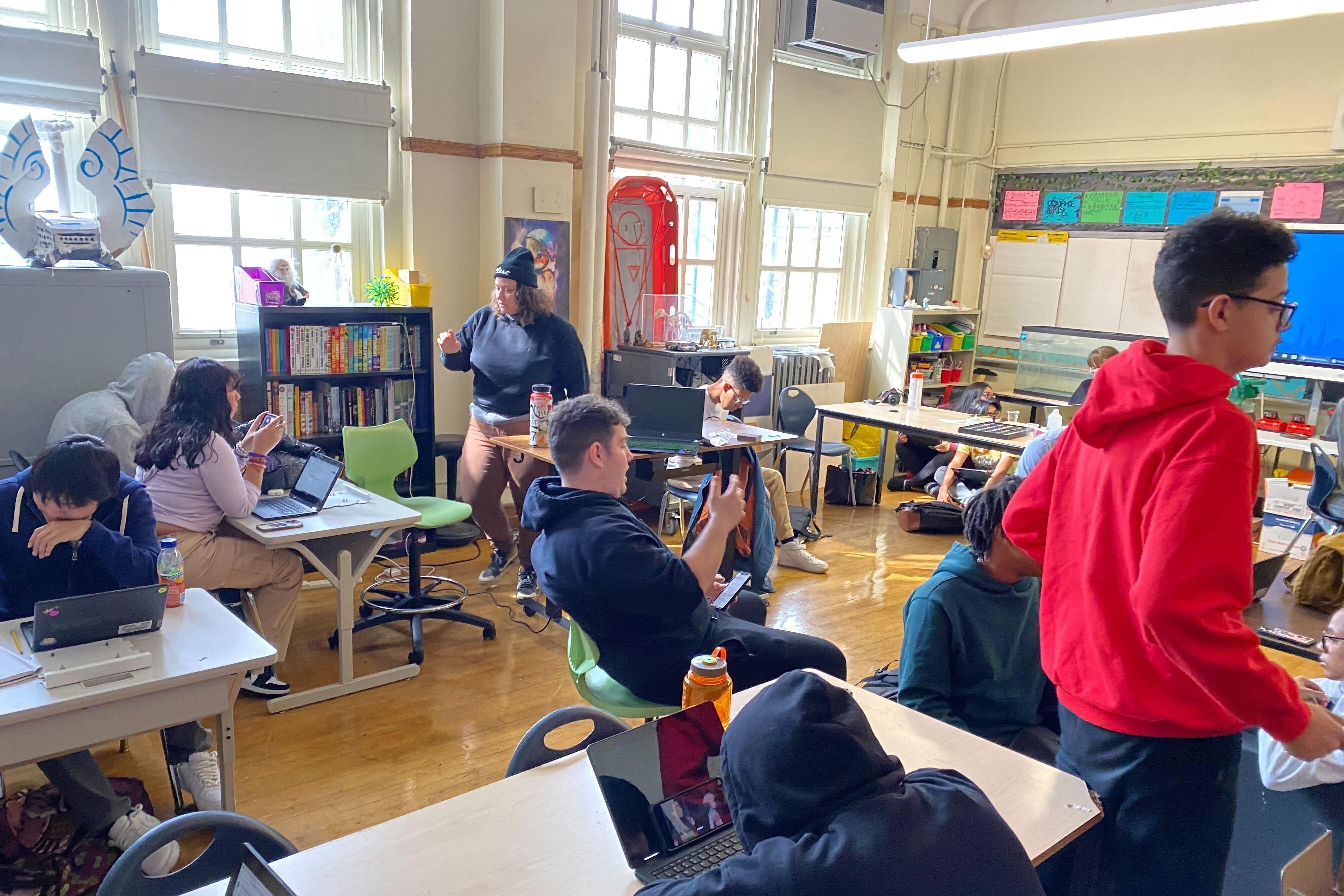Many education advocates cheered when Gov. Kathy Hochul signed into law last September a five-year plan to reduce class sizes in New York City’s public schools.
For the first year, however, the city’s education department plans to make no changes, according to a draft plan shared with reporters on Friday.
Under that plan — which is supposed to spell out how the city will meet the law’s new requirements — class sizes will remain the same in September. That’s because the education department says that enough of its core classes — an average 39% — for K-12 exceed the requirements in the law for the first year of the plan. (The plan only affects city-run schools, not charters.)
But, for future school years, education department officials are bracing for some big expenses to comply with the law. They estimate it will cost $1.3 billion a year for new teachers when the plan is fully implemented as well as about $30-$35 billion in capital expenditures to construct new spaces or reconfigure old ones.
The education department said it would gather feedback from the public and educators to determine the best way to shrink class sizes by 2028, when state law requires that the entire school system meet the new requirements.
The city teachers union — one of the entities that must approve the plan — blasted the education department’s effort, emphasizing that they will work with the state to ensure the city “fulfills its obligations” of the law.
“Meeting the new class size standards is going to require a real plan — and so far, the DOE hasn’t managed to create one,” said teachers union president Michael Mulgrew in a statement. “This document is missing a strategy for implementation and a targeted proposal for where and when new seats should be built.”
Education department spokesperson Nathaniel Styer responded in a statement that the draft was created after consulting “extensively” with the unions, and they will continue to be able to share feedback.
“The tradeoffs involved in implementation are too important to be made behind closed doors and our entire community must be involved in informing these decisions,” Styer said.
The education department will begin collecting public comment on the plan, which is posted online, in June. Within two weeks of the end of that process, officials must submit the plan to the state education department for approval.
Here are seven things to know:
What are the new class-size caps?
Kindergarten through third grade should have no more than 20 children.
From grades four through eighth, classes should have no more than 23 students, while students in ninth through 12th grades can have up to 25 students.
That’s down from a previous cap of 25 students for kindergarten, and 32 students in the rest of elementary school grades, according to the teachers union contract agreement. Middle and high schools were supposed to be capped previously at 33 and 34 students, respectively, with a 30-student limit in Title 1 middle schools (where at least 60% of students are from low-income families).
What will change next year in terms of class-size reductions?
Nothing. State law requires 20% of the city’s classrooms be in compliance with the new state law each year, reaching 100% by 2028. According to the education department, an average 39% of classes meet the new requirements, meaning they expect to meet the state’s requirements for next school year. This includes elementary school homerooms, where children receive their core instruction, and core subject classes for grades 6-12 — meaning math, science, social studies, and English courses, including gifted and talented, integrated co-teaching, which includes a mix of students with and without disabilities, and accelerated courses.
Ninety-one percent of performing arts and gym courses are in compliance.
In year two, 40% of classes must comply, then 60% and 80% until the final year when all classes are expected to meet the targets (unless they get exemptions).
How will the education department shrink class sizes by 2028?
We don’t know the details yet, but the education department offered some clues in its plan.
From May to October, the education department plans to meet regularly with a working group that it convened this spring to gather feedback on how to meet the law’s new requirements.
Officials wrote that they will identify additional classrooms for space; work with the city’s School Construction Authority on the next capital plan, which lays out building plans for the school system; and would focus on high-poverty schools not meeting requirements, as required by the law.
Starting in November, officials will begin changing policies “and reprioritization of programming” in order to meet the class-size mandates. Officials did not immediately explain what sort of policies or programs would change. But before the law passed, Chancellor David Banks warned that the law could mean a cut in school services or programming because of the cost of creating more classes.
Who will be exempt from the class-size law?
Any exemptions must be approved by the chancellor, as well as the heads of the teachers union and the union representing principals and other administrators. Disagreements will head to arbitration, the law mandates.
Schools might be exempt because of space limitations, but the education department will have to show that they are working to resolve the issue through their capital budget plan. Schools that are overenrolled or ones in which they would face severe economic hardship to comply might get exemptions. (The plan offered no other information on this.) There might be exemptions for schools where they have insufficient numbers of teachers in subjects that are hard to fill, like bilingual math; the teachers union can negotiate higher class sizes for electives and specialty classes if the majority of a school’s staff approves the increase.
Does the law prioritize any particular schools in regards to meeting the new class-size mandates?
The law requires the education department to start with schools with high shares of students living in poverty. In its plan, the education department said that schools with the highest numbers of low-income students are more likely to have smaller class sizes.
Fifty-nine percent of classes meet the new requirements at schools with the most students from low-income families, according to education department data shared in the plan. In contrast, schools with the fewest students living in poverty have just 23% of classes meeting the new requirements.
Where else are schools more — or less — likely to meet the class-size mandates?
Schools with larger classes also hew closely to racial demographics. Roughly 54% of classes already meet the class-size targets at schools with the highest percentage of Black students compared to schools with the highest percentage of Asian and white students, where only about a quarter of classes meet the targets.
Three Brooklyn districts — Ocean Hill/Brownsville’s District 23, Crown Heights’ District 16, and District 18 in Canarsie/East Flatbush had the greatest share of classes at or below the caps, according to the education department data. These three districts have among the highest shares of Black students in the city.
Two Queens districts — Bayside’s District 26 and Flushing’s District 25 — along with Staten Island’s District 31 have the lowest share of classes that meet the targets. District 25 and 26 have the city’s highest share of Asian students, while District 31 has the highest share of white students.
Of the five boroughs, the Bronx might have the easiest time meeting the class-size caps, with 50% of its schools already hitting the targets. Staten Island could have the most challenges, with only 22% of its schools meeting the class size requirements.
Schools that have grades 6-12 or 9-12 are more likely to have smaller class sizes, the figures show, with about 44% of these schools already meeting the new class-size mandates. Only 30% of standalone middle schools meet the targets, followed by K-8 and K-5 schools.
What happens next?
The education department must collect public comments on the plan and then submit it to the state education department for final approval. The teachers and principals unions must also sign off on the plan, which must go into effect in September.
Next month, city officials are holding online public hearings for each borough via Zoom on the following dates, starting at 6 p.m.:
Staten Island: Friday, June 2
Queens: Tuesday, June 6
Brooklyn: Thursday, June 8
Manhattan: Tuesday, June 13
The Bronx: Thursday, June 15
The city will have two weeks to analyze the public comments before submitting its final proposal to the state.
Reema Amin is a reporter covering New York City public schools. Contact Reema at ramin@chalkbeat.org.
Amy Zimmer is the bureau chief for Chalkbeat New York. Contact Amy at azimmer@chalkbeat.org.








